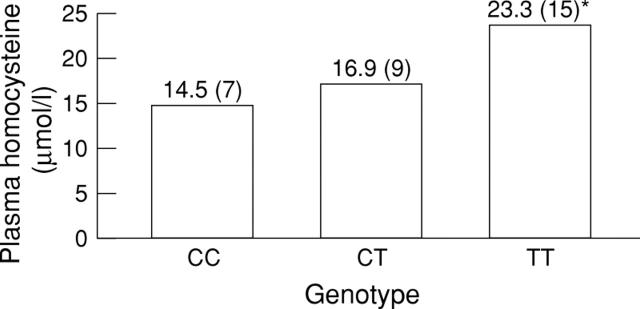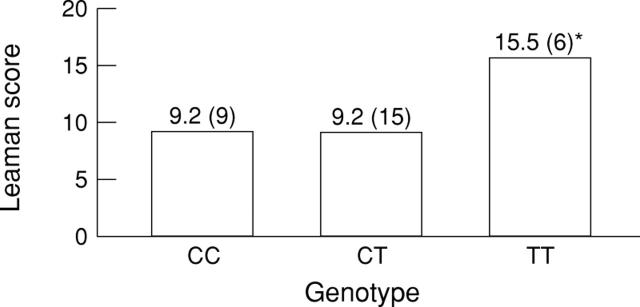Abstract
OBJECTIVE—To determine the effects of the thermolabile methylene tetrahydrofolate reductase (MTHFR) mutation on the presence and extent of coronary atherosclerosis in a population with low plasma folate. METHODS—242 consecutive patients undergoing coronary angiography were prospectively evaluated for conventional risk factors, plasma homocysteine, vitamin B-12, and folate, and MTHFR genotype. The severity of coronary atherosclerosis was determined by the Leaman score. RESULTS—Mean (SD) plasma homocysteine was 15.6 (10) µmol/l in controls and 18.5 (11) µmol/l in patients with coronary artery disease (p > 0.05). Plasma homocysteine concentrations above 15 µmol/l were a risk factor for coronary artery disease (p = 0.03, risk ratio 2.1, 95% confidence interval (CI) 1.07 to 4.4). Homocysteine remained an independent risk factor on multivariate analysis when conventional risk factors were taken into account (p = 0.04). Homocysteine concentrations above 15 µmol/l were correlated with the extent of atherosclerosis (p = 0.04, risk ratio 3.2, 95% CI 1.3 to 8.2). Homocysteine had no effect on other lipid variables (p > 0.05). Plasma folate was 15.8 (7.2) nmol/l in controls and 11.5 (2.9) nmol/l in patients with coronary artery disease. Plasma folate concentrations below 12.9 nmol/l (5.7 ng/ml) conferred a risk for coronary artery disease (p = 0.03, risk ratio 2.42, 95% CI 1.05 to 5.59). When the MTHFR genotype was determined, the TT genotype was present in 7.4% of patients and 5.2% of controls (p > 0.05). The prevalence of alleles was within the Hardy-Weinberg equilibrium (TT 7, CT 40, CC 53, χ2 = 2.3, p = 0.3). The highest homocysteine concentrations were found in patients with the TT genotype and folate below the median of the population (p = 0.01). The extent of coronary atherosclerosis judged by the Leaman score was significantly higher in patients with the TT genotype (p = 0.03). CONCLUSIONS—Plasma homocysteine over 15 µmol/l was a significant risk factor for the presence and extent of coronary artery disease. The mean plasma folate of the population was low and correlated negatively with homocysteine. Although TT genotype was not an independent predictor of coronary artery disease, it was an important predictor of the extent of coronary atherosclerosis and plasma homocysteine, especially in the presence of plasma folate values below the median of the population. These findings may have important implications for folate replacement in patients with the TT genotype. Keywords: coronary artery disease; vitamin B-12; folate; MTHFR mutation
Full Text
The Full Text of this article is available as a PDF (127.8 KB).
Figure 1 .
The distribution of plasma homocysteine concentrations according to genotype. *p = 0.001, CC v TT.
Figure 2 .
The distribution of Leaman scores according to genotype. *p = 0.03, CC v TT.
Selected References
These references are in PubMed. This may not be the complete list of references from this article.
- Boduroglu K., Alikasifoglu M., Anar B., Tuncbilek E. 677-->CT mutation on the methylenetetrahydrofolate reductase gene is not a risk factor for neural tube defects in Turkey. Arch Dis Child Fetal Neonatal Ed. 1998 May;78(3):F235–F235. doi: 10.1136/fn.78.3.f234c. [DOI] [PMC free article] [PubMed] [Google Scholar]
- Boushey C. J., Beresford S. A., Omenn G. S., Motulsky A. G. A quantitative assessment of plasma homocysteine as a risk factor for vascular disease. Probable benefits of increasing folic acid intakes. JAMA. 1995 Oct 4;274(13):1049–1057. doi: 10.1001/jama.1995.03530130055028. [DOI] [PubMed] [Google Scholar]
- Daly L., Robinson K., Tan K. S., Graham I. M. Hyperhomocysteinaemia: a metabolic risk factor for coronary heart disease determined by both genetic and environmental influences? Q J Med. 1993 Oct;86(10):685–689. doi: 10.1093/qjmed/86.10.685. [DOI] [PubMed] [Google Scholar]
- Folsom A. R., Nieto F. J., McGovern P. G., Tsai M. Y., Malinow M. R., Eckfeldt J. H., Hess D. L., Davis C. E. Prospective study of coronary heart disease incidence in relation to fasting total homocysteine, related genetic polymorphisms, and B vitamins: the Atherosclerosis Risk in Communities (ARIC) study. Circulation. 1998 Jul 21;98(3):204–210. doi: 10.1161/01.cir.98.3.204. [DOI] [PubMed] [Google Scholar]
- Frantzen F., Faaren A. L., Alfheim I., Nordhei A. K. Enzyme conversion immunoassay for determining total homocysteine in plasma or serum. Clin Chem. 1998 Feb;44(2):311–316. [PubMed] [Google Scholar]
- Frosst P., Blom H. J., Milos R., Goyette P., Sheppard C. A., Matthews R. G., Boers G. J., den Heijer M., Kluijtmans L. A., van den Heuvel L. P. A candidate genetic risk factor for vascular disease: a common mutation in methylenetetrahydrofolate reductase. Nat Genet. 1995 May;10(1):111–113. doi: 10.1038/ng0595-111. [DOI] [PubMed] [Google Scholar]
- Harker L. A., Ross R., Slichter S. J., Scott C. R. Homocystine-induced arteriosclerosis. The role of endothelial cell injury and platelet response in its genesis. J Clin Invest. 1976 Sep;58(3):731–741. doi: 10.1172/JCI108520. [DOI] [PMC free article] [PubMed] [Google Scholar]
- Jacques P. F., Bostom A. G., Williams R. R., Ellison R. C., Eckfeldt J. H., Rosenberg I. H., Selhub J., Rozen R. Relation between folate status, a common mutation in methylenetetrahydrofolate reductase, and plasma homocysteine concentrations. Circulation. 1996 Jan 1;93(1):7–9. doi: 10.1161/01.cir.93.1.7. [DOI] [PubMed] [Google Scholar]
- Kang S. S., Wong P. W., Susmano A., Sora J., Norusis M., Ruggie N. Thermolabile methylenetetrahydrofolate reductase: an inherited risk factor for coronary artery disease. Am J Hum Genet. 1991 Mar;48(3):536–545. [PMC free article] [PubMed] [Google Scholar]
- Leaman D. M., Brower R. W., Meester G. T., Serruys P., van den Brand M. Coronary artery atherosclerosis: severity of the disease, severity of angina pectoris and compromised left ventricular function. Circulation. 1981 Feb;63(2):285–299. doi: 10.1161/01.cir.63.2.285. [DOI] [PubMed] [Google Scholar]
- Malinow M. R., Nieto F. J., Kruger W. D., Duell P. B., Hess D. L., Gluckman R. A., Block P. C., Holzgang C. R., Anderson P. H., Seltzer D. The effects of folic acid supplementation on plasma total homocysteine are modulated by multivitamin use and methylenetetrahydrofolate reductase genotypes. Arterioscler Thromb Vasc Biol. 1997 Jun;17(6):1157–1162. doi: 10.1161/01.atv.17.6.1157. [DOI] [PubMed] [Google Scholar]
- McCully K. S. Vascular pathology of homocysteinemia: implications for the pathogenesis of arteriosclerosis. Am J Pathol. 1969 Jul;56(1):111–128. [PMC free article] [PubMed] [Google Scholar]
- Meleady R. A., Mulcahy D. A., Graham I. M. Genes, greens, and homocysteine. Heart. 1996 Aug;76(2):103–104. doi: 10.1136/hrt.76.2.103. [DOI] [PMC free article] [PubMed] [Google Scholar]
- Montalescot G. Homocysteine: the new player in the field of coronary risk. Heart. 1996 Aug;76(2):101–102. doi: 10.1136/hrt.76.2.101. [DOI] [PMC free article] [PubMed] [Google Scholar]
- Morita H., Taguchi J., Kurihara H., Kitaoka M., Kaneda H., Kurihara Y., Maemura K., Shindo T., Minamino T., Ohno M. Genetic polymorphism of 5,10-methylenetetrahydrofolate reductase (MTHFR) as a risk factor for coronary artery disease. Circulation. 1997 Apr 15;95(8):2032–2036. doi: 10.1161/01.cir.95.8.2032. [DOI] [PubMed] [Google Scholar]
- Morrison H. I., Schaubel D., Desmeules M., Wigle D. T. Serum folate and risk of fatal coronary heart disease. JAMA. 1996 Jun 26;275(24):1893–1896. doi: 10.1001/jama.1996.03530480035037. [DOI] [PubMed] [Google Scholar]
- Nishinaga M., Ozawa T., Shimada K. Homocysteine, a thrombogenic agent, suppresses anticoagulant heparan sulfate expression in cultured porcine aortic endothelial cells. J Clin Invest. 1993 Sep;92(3):1381–1386. doi: 10.1172/JCI116712. [DOI] [PMC free article] [PubMed] [Google Scholar]
- Omenn G. S., Beresford S. A., Motulsky A. G. Preventing coronary heart disease: B vitamins and homocysteine. Circulation. 1998 Feb 10;97(5):421–424. doi: 10.1161/01.cir.97.5.421. [DOI] [PubMed] [Google Scholar]
- Onat A., Dursunoğlu D., Sansoy V. Relatively high coronary death and event rates in Turkish women. Relation to three major risk factors in five-year follow-up of cohort. Int J Cardiol. 1997 Aug 29;61(1):69–77. doi: 10.1016/s0167-5273(97)00121-6. [DOI] [PubMed] [Google Scholar]
- Onat A., Senocak M. S. Relative risk of factors for coronary heart disease in population with low cholesterol levels. Int J Cardiol. 1994 Jan;43(1):51–60. doi: 10.1016/0167-5273(94)90090-6. [DOI] [PubMed] [Google Scholar]
- Pancharuniti N., Lewis C. A., Sauberlich H. E., Perkins L. L., Go R. C., Alvarez J. O., Macaluso M., Acton R. T., Copeland R. B., Cousins A. L. Plasma homocyst(e)ine, folate, and vitamin B-12 concentrations and risk for early-onset coronary artery disease. Am J Clin Nutr. 1994 Apr;59(4):940–948. doi: 10.1093/ajcn/59.4.940. [DOI] [PubMed] [Google Scholar]
- Robinson K., Arheart K., Refsum H., Brattström L., Boers G., Ueland P., Rubba P., Palma-Reis R., Meleady R., Daly L. Low circulating folate and vitamin B6 concentrations: risk factors for stroke, peripheral vascular disease, and coronary artery disease. European COMAC Group. Circulation. 1998 Feb 10;97(5):437–443. doi: 10.1161/01.cir.97.5.437. [DOI] [PubMed] [Google Scholar]
- Stampfer M. J., Malinow M. R., Willett W. C., Newcomer L. M., Upson B., Ullmann D., Tishler P. V., Hennekens C. H. A prospective study of plasma homocyst(e)ine and risk of myocardial infarction in US physicians. JAMA. 1992 Aug 19;268(7):877–881. [PubMed] [Google Scholar]
- Tonstad S. Correlates of plasma total homocysteine in patients with hyperlipidaemia. Eur J Clin Invest. 1997 Dec;27(12):1025–1029. doi: 10.1046/j.1365-2362.1997.2260772.x. [DOI] [PubMed] [Google Scholar]
- Tsai J. C., Perrella M. A., Yoshizumi M., Hsieh C. M., Haber E., Schlegel R., Lee M. E. Promotion of vascular smooth muscle cell growth by homocysteine: a link to atherosclerosis. Proc Natl Acad Sci U S A. 1994 Jul 5;91(14):6369–6373. doi: 10.1073/pnas.91.14.6369. [DOI] [PMC free article] [PubMed] [Google Scholar]
- van Bockxmeer F. M., Mamotte C. D., Vasikaran S. D., Taylor R. R. Methylenetetrahydrofolate reductase gene and coronary artery disease. Circulation. 1997 Jan 7;95(1):21–23. doi: 10.1161/01.cir.95.1.21. [DOI] [PubMed] [Google Scholar]




